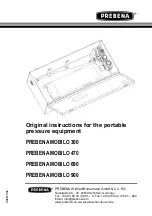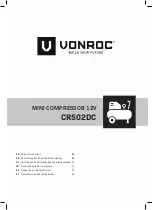
6
LEAKAGE TESTS
See the standard Air Brake System and Accessory Leakage
test on Page A-15 (Test 2).
Note:
Leakage in the air supply system (components
before the supply reservoir - such as the governor, air dryer,
reservoir drain cocks, safety valve, and check valves) will
not be registered on the vehicle dash gauges and must
be tested separately. Refer to the various maintenance
manuals for individual component leakage tests and the
Bendix “Test and Checklist” published in the Bendix
®
Air
Brake System Handbook (BW5057) and on the back of
the Bendix
®
Dual Circuit Brake System Troubleshooting
Card (BW1396).
CYLINDER HEAD
Check the cylinder head gaskets for air leakage.
1. With the engine running, lower air system pressure to
60 psi and apply a soap solution around the cylinder
head. Check the two gaskets between the cylinder
head and the valve plate assembly, as well as the inlet
reed valve/gasket between the valve plate assembly
and crankcase for air leakage.
2. No leakage is permitted. If leakage is detected, replace
the compressor or repair the cylinder head using the
maintenance kit available from an authorized Bendix
parts outlet.
INLET & DISCHARGE VALVES
In order to test the inlet and discharge valves, it is necessary
to have shop air pressure and an assortment of fi ttings. A
soap solution is also required.
1. With the engine shut off, drain ALL air pressure from
the vehicle.
2. Disconnect the inlet and discharge lines.
3. Apply 120-130 psi shop air pressure to the discharge
port and then apply and release air pressure to the inlet
port. Soap the inlet port and note that leakage at the
inlet port does not exceed 200 sccm.
If excessive leakage is noted in Test 3, replace or repair
the compressor using genuine Bendix replacements or
maintenance kits available from any authorized Bendix
parts outlet.
While it is possible to test for inlet and discharge leakage,
it may not be practical to do so. Inlet and discharge valve
leakage can generally be detected by longer compressor
build-up and recovery times. Compare current compressor
build-up times with the last several recorded times. Make
certain to test for air system leakage, as described under
“In-Service Operating Tests”, before making a determination
that performance has been lost.
COMPRESSOR REMOVAL & DISASSEMBLY
GENERAL
The following disassembly and assembly procedure is
presented for reference purposes and pre-supposes that
a rebuild or repair of the compressor is being undertaken.
Several maintenance kits are available and the instructions
provided with these parts and kits should be followed in
lieu of the instructions presented here.
MAINTENANCE KITS & SERVICE PARTS
BENDIX
®
360CC SINGLE CYLINDER
COMPRESSOR ONLY
Compressor Seal Kit (Major) . . . . . . . . . K026807
Compressor Seal Kit (Minor) . . . . . . . . . K051352
Discharge Safety Valve Kit . . . . . . . . . . K026809
Compressor to Engine Mounting Face Sealant
. . . . . . . . . . Supplied by the Engine Manufacturer
GENERAL SAFETY GUIDELINES
WARNING! PLEASE READ AND FOLLOW
THESE INSTRUCTIONS TO AVOID PERSONAL
INJURY OR DEATH:
When working on or around a vehicle, the following
general precautions should be observed at all times.
1. Park the vehicle on a level surface, apply the parking
brakes, and always block the wheels. Always wear
safety glasses.
2. Stop the engine and remove ignition key when working
under or around the vehicle. When working in the engine
compartment, the engine should be shut off and the
ignition key should be removed. Where circumstances
require that the engine be in operation, EXTREME
CAUTION should be used to prevent personal injury
resulting from contact with moving, rotating, leaking,
heated or electrically charged components.
3. Do not attempt to install, remove, disassemble or
assemble a component until you have read and
thoroughly understand the recommended procedures.
Use only the proper tools and observe all precautions
pertaining to use of those tools.
4. If the work is being performed on the vehicle’s air brake
system, or any auxiliary pressurized air systems, make
certain to drain the air pressure from all reservoirs
before beginning ANY work on the vehicle. If the vehicle
is equipped with a Bendix
®
AD-IS
®
air dryer system or
a dryer reservoir module, be sure to drain the purge
reservoir.
Summary of Contents for 360CC
Page 12: ...12 Notes...







































